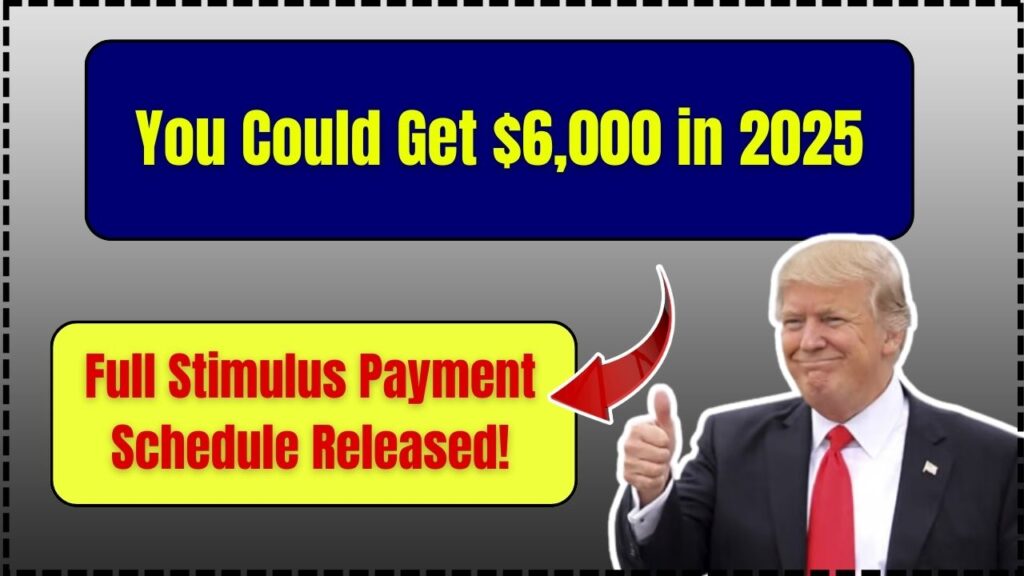You Could Get $6,000 in 2025: In 2025, several U.S. states are offering up to $6,000 in stimulus payments to eligible residents. These programs are designed to help low- and middle-income individuals and families navigate rising living costs and economic challenges. Unlike previous federal stimulus payments, these are state-led initiatives, typically distributed in monthly installments.

This guide explains who qualifies, how much you can receive, how to apply, and what to expect throughout the process—all in a simple and accessible format.
You Could Get $6,000 in 2025
| Feature | Details |
|---|---|
| Total Benefit | $6,000 annually (typically $500/month) |
| States Participating | California, Michigan, New Mexico, New York, Washington |
| Additional Child Benefit | Up to $350 per child (maximum of 2 children) |
| Eligibility Criteria | Based on income, residency, and recent tax filings |
| Application | Through state government websites |
| Payment Methods | Direct deposit, paper checks, prepaid debit cards |
| Tax Implication | Not considered taxable income |
| Benefit Duration | Typically 12 months per applicant starting 2024–2025 |
The $6,000 state stimulus checks in 2025 offer an important financial lifeline for working individuals and families. By understanding the eligibility rules, preparing the right documents, and applying through your state’s website, you can take full advantage of this program.
Understanding the $6,000 State Stimulus Programs
These stimulus programs provide $500 per month over 12 months, totaling $6,000. Some states include additional payments per child, up to two children, significantly increasing the total aid a household can receive.
This initiative is different from one-time federal checks. It’s structured to offer consistent, predictable support, helping families with essentials like food, rent, and child care.
States Offering the $6,000 Stimulus in 2025
Here’s a comparison of what different states are offering:
| State | Monthly Amount | Max Annual | Extra for Children? |
|---|---|---|---|
| California | $500 | $6,000 | Yes ($350/child) |
| Michigan | $500 | $6,000 | No |
| New York | $500 | $6,000 | Yes (varies) |
| New Mexico | $500 | $6,000 | No |
| Washington | $500 | $6,000 | Yes (up to $250/child) |
Eligibility Requirements (By State)
Each state sets its own eligibility standards, but most programs include the following:
- Residency: You must live in the state where you’re applying.
- Income Limits: Generally capped at $75,000 for single filers or $150,000 for joint filers.
- Tax Filing: You need to have filed your 2023 or 2024 taxes.
- Identification: Must have a valid Social Security Number (SSN) or Individual Taxpayer Identification Number (ITIN).
- Other Benefits: Receiving other aid, such as SNAP or SSDI, might affect eligibility but doesn’t always disqualify you.
You Could Get $6,000 in 2025 Apply
- Check Eligibility: Review your state’s income thresholds, residency criteria, and program requirements.
- Gather Documents:
- You’ll likely need:
- Proof of income (tax returns, pay stubs)
- Proof of residency (utility bill, lease)
- Government-issued ID
- Bank account information for direct deposit
- Apply Online: Most states provide an online application portal. Fill it out carefully and double-check your details before submitting.
- Follow Up: Track your application and respond to any additional requests for verification to avoid delays.
Real-Life Example
Maria, a single mother in New York, earns $42,000 annually. She qualified for the base $500/month and received an extra $350 for her daughter. That’s $850/month, totaling over $10,000 a year—enough to cover rent for several months or build emergency savings.
What If You’re Denied?
- File an Appeal: Most states allow appeals if you believe your application was unfairly rejected.
- Correct Errors: Typos or mismatches in your tax return or ID number can lead to denial.
- Explore Alternatives: If denied, look into housing assistance, child tax credits, or local relief programs.
Tips to Maximize Your Benefits
- File taxes early to ensure timely eligibility.
- Link a checking account for faster payments.
- Track program deadlines—some states operate on a first-come, first-served basis.
- Combine with other benefits to stretch your financial support (e.g., food stamps, child care credits).
Expert Insight
“These programs reflect a shift in how states address poverty—moving from one-time checks to consistent income support,” says a public policy expert. “For working families, $500 a month can mean the difference between stability and struggle.”
8 Rare Dimes and a Bicentennial Quarter Worth $52 Million Each: Find it and sell it ASAP
New Social Security ID Checks Coming: How to Set Up Your “my Social Security” Account
Claim Up to $5180 Monthly with Social Security in 2025 – Check Eligibility & Payment Date
FAQs On You Could Get $6,000 in 2025
1. Can I still apply in the middle of 2025?
Yes. However, you will only receive payments for the months remaining in the program year.
2. Are non-citizens eligible?
In some states, yes—as long as you have a valid ITIN and meet the other requirements.
3. Will this reduce my tax refund?
No. The stimulus is not considered taxable income and does not affect your refund.
4. Can I apply in more than one state?
No. You must apply in your current state of legal residence. Multiple applications can disqualify you.








